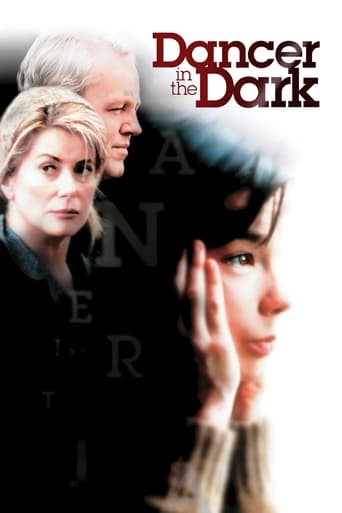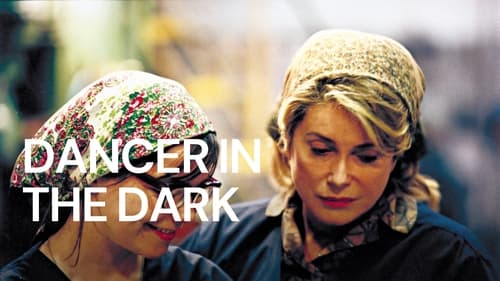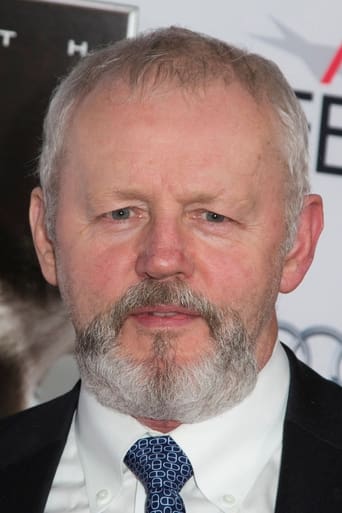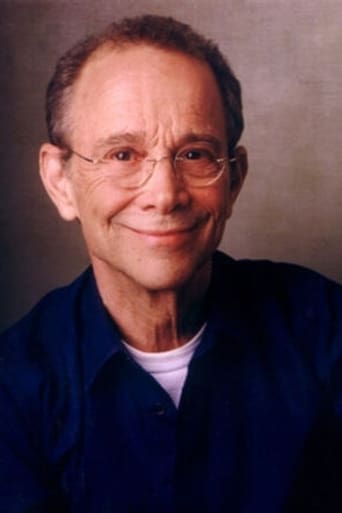Greenes
Please don't spend money on this.
Holstra
Boring, long, and too preachy.
Dorathen
Better Late Then Never
Blake Rivera
If you like to be scared, if you like to laugh, and if you like to learn a thing or two at the movies, this absolutely cannot be missed.
catalina
I only saw this movie once, while I was in high school. I watched it over the course of a whole weekend, as I had to stop each 15 minutes for crying. It is the most heartbreaking movie about the injustice there is in the world, about the beauty of emotional and good hearted people. It portrays love, but in a way that it has no power, if not for the beauty it brings for a moment in time. It still remains the saddest movie I have seen in my life. Bjork is delivering such beautiful acting.
sharky_55
The films of Lars von Trier can be likened to a little boy with a stick. He pokes and prods at incapacitated wild animals, aiming to hurt and bring about squeals of pain, relishing in these reactions and putting off the mercy of death for curiosity's sake. Lars von Trier, of course, is not a little boy, and knows exactly what he is doing and the gravity of his actions. In Dancer in the Dark, his critique takes aim at American escapist musicals where the protagonists can whisk away their worries with a dance and song - in contrast, Selma is harshly jerked out of her percussive daydreams and brought back to reality. Selma is the dumb tortured animal is this scenario, so simple- minded, so incapable of self-pity, and perpetually detached from the life that she leads. So obviously she's a perfect tool for Trier, who blames anyone and everyone for her demise, offering little awareness of any cause and effect, or an escape route. She's a poor Czech immigrant toiling away in America, but that hardly even matters. For the wealth of sociopolitical issues to mine here the setting is made bare of any context. Trier improved on this in Dogville, which at least dropped Nicole Kidman into an allegorical capitalist society where she has to work for room and board. But here Trier wields his characters like dummies to be bashed and bashed for devastation's sake. Selma is offered no agency but continually assaulted by events far beyond her or the film's comprehension. She's little more than a child with initially wide eyes and pixie-ish features; she has a son of her own but no scene to present any notion of maturity, motherhood or devotion towards him, and keeps what little of her earned wages in a candy box like a little girl saving up pocket money. Björk, to her credit, is suitable, making a whole show of gradually squinting and retreating into her songs, but even she can't justify being this delightfully twee and naive in the face of impending doom. It's too easy of a target to shoulder the film's events, and it doesn't earn our sympathies so much as break down sobbing and begging for them. Arresting is one word that has been used to describe Trier's style. Another would be condescending, both towards his characters and audiences. He wields his cameras as if he was part of a hyperactive news crew at the scene of some devastating crime, and you can practically feel the nervy shakiness and excitement at being able to capture and profit from such misery. His clumsy, unstable zooms (that awful final shot of the glasses) intrude on the characters and their emotions, fetishising their fragility in suffocating extreme close- ups. These shots talk down to audiences, as if we could not sympathise unless the camera is thrust right into their faces and the punishment unrepealable. The musical sequences were filmed simultaneously with over a hundred DV cameras, and the drop in quality shows. Although some are inspired, making full use of the inventiveness of Selma's imagination and her child-like glee, floating in and out of reality, they are visually appalling. Perhaps it's Trier's Dogme 95 ties, preventing him from lighting the sequences with anything other than the dim, dusty overhead lights of the factory, rendering all the splashes of imaginary colour in the mise en scène depressingly drab. Or perhaps it's the fact that he continually cuts from dozens of different perspectives of his coverage, without any visible method in the madness but simply because the setup allows him that privilege. If it's supposed to be an attack on Hollywood's fondness with continuity editing it's another black mark for Trier: abrasive for abrasiveness' sake. The Dardenne brothers are a pair of recent filmmakers with similar stylistic goals, and who also focus on the plight of the lower class. But they are not nearly as condescending to their characters as Trier is, who saps Selma of all her dignity and turns her into a prop for an emotional beatdown. In her confrontation with Bill she turns into a hysterical and tragic mess, sobbing and fumbling blindly for the gun but only managing to wound him with the bullets. She then staggers around and finally finishes him off with the deposit box. The sheer absurdity of this scene (why not simply get a head start on the police instead of asking a blind girl to commit murder - and why does she look away and fire blindly instead of feeling for his head and shooting point blank) is coupled with Trier's persistence to lengthen it. He milks and milks the tragedy for all its worth, barreling the camera right into Selma's weeping face, and in the end it becomes hilarious in its ridiculousness. It's unbelievable that no one has turned this into a skit or gag: a lowly, suicidal man asks his friend to pull the trigger, only she's blind and has atrocious aim. He holds it up to his temple for her, she squeezes, and the vase on the shelf six feet to the right explodes. Above all, this is stylised realism, ironic for one of the founders of Dogme 95. He did this in Breaking the Waves too, transferring the film stock onto video and then back again for extra dose of graininess. In this bizarre scene the pair stumble and slip and fall all over the place, setting up additional opportunities for Trier to insert more misery. Just like Haneke gleefully claps his hands every time someone walks out of Funny Games, Trier is lapping up the tears born out of Dancer in the Dark.
William O. Tyler
The film fades from black and opens like eyesight coming into focus for the first time. As fine art continues to fade in and out, a motif evocative of bursted capillaries takes over. This is Dancer in the Dark, a film by Lars Von Trier about Selma, a foreign immigrant woman in 1960s Washington State who loves movie musicals but is slowly going blind. The film is a musical itself, but a very unconventional one. It's not the glamorous romp that Selma sees on the big screen. Instead, it's a rough around the edges look at escapism and perceived Americana that showcases the contrast of how we use sight, sound and imagination to get through our everyday lives.Most of the movie looks more like a documentary, very much like real life. It's so unpolished that it seems like improv, like everything is being made up on the fly or that the camera is just capturing these real, personal events. Of course as the story continues you know that everything is indeed planned and once you get to the first musical number, which doesn't happen until nearly 40 minutes in, everything is actually specifically choreographed. While these real life moments were filmed with what seems to be a single hand-held camera, the musical moments become dreamlike and are shot with over 100 digital cameras placed around the location to catch every move from every angle. This footage was then edited to give a sense of stability within Selma's mind, standing out from her otherwise rocky life. It's quite ingenious.The cast is filled with actors' actors that each bring truth to their characters no matter how big or small the role is. Veteran actress Catherine Denueve is abrasive but supportive as Selma's friend and coworker, Peter Stormare is sympathetic as a man after Selma's affection and David Morse really pushes the film to new points as Selma's neighbor and landlord. Cara Seymour, Siobhan Fallon, Udo Kier, Stellan Skarsgård, Vladica Kostic and Joel Grey are all also in smaller roles, though still as equally important to the film. Icelandic singer Björk, who has a limited experience with acting, stars as Selma herself and brings veracity, sincerity and an incredibly raw experience to the character.Selma struggles between being a woman of her word, holding her ground and simultaneously feeling helpless. She's dealing with her own personal burdens, being a single mother trying to give her son a future he can see, and the burdens given to her by others, being a friend in a position where she doesn't have much of a choice to make. Many might question why Selma doesn't take the easy road through her situation, but that's just the point. She is so innocent and her moral convictions are so strong that she never even feels the need to. It might seem like an unrealistic decision to make, but it's only as unrealistic as any other movie musical, just in the opposite direction.Dancer in the Dark completes Von Trier's Golden Hearts Trilogy of films in which the heroine remains naive despite her experiences. It should also be noted that the Danish director's view of vintage America is a view from afar as the director has very rarely if ever even been to America and the film was shot in Denmark. The portrayal here of small town American living and the American justice system are skewed and exaggerated, a bit simple but still unsurprising. It's a heartbreaking and unsettling film that you will assuredly not clap for at the end, as you might a usual musical, despite whether you appreciate it or not.
davikubrick
Trier is a polemic director who constantly looks only for the shock, but behind the shock there is a message, but sometimes even the message can be "messed up" in some (or most) of his films. Here he delivers a tragic story mostly made for the shock and make the audience cry, and even thought it's a incredibly forced movie, Trier can manage what he wants in some viewers: make them cry. The characters are simple, they have problems (mostly or only of moral, financial and of health), Björk performance is great but her character is too simple (not very well developed). "Dancer in the Dark" is a haunting film, it's incredibly simple and extremely forced, but some how, Trier ended up getting some emotion (even if in a forced way) of the viewer.









